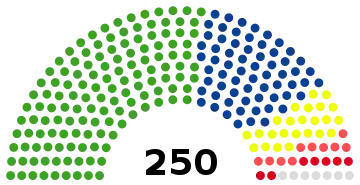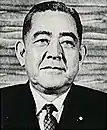| |||||||||||||||||||||||||||||||||||||||||||||||||||||||||||||
126 of the 250 seats in the House of Councillors 126 seats needed for a majority | |||||||||||||||||||||||||||||||||||||||||||||||||||||||||||||
|---|---|---|---|---|---|---|---|---|---|---|---|---|---|---|---|---|---|---|---|---|---|---|---|---|---|---|---|---|---|---|---|---|---|---|---|---|---|---|---|---|---|---|---|---|---|---|---|---|---|---|---|---|---|---|---|---|---|---|---|---|---|
| |||||||||||||||||||||||||||||||||||||||||||||||||||||||||||||
| |||||||||||||||||||||||||||||||||||||||||||||||||||||||||||||
| This article is part of a series on |
| Politics of Japan |
|---|
 |
|
|
House of Councillors elections were held in Japan on 7 July 1968,[1] electing half the seats in the House. The Liberal Democratic Party won the most seats, although this marked the first House of Councillors election in the LDP's history in which its share of the popular vote decreased when compared to the election prior to it.
Results
 | ||||||||||||
|---|---|---|---|---|---|---|---|---|---|---|---|---|
| Party | National | Constituency | Seats | |||||||||
| Votes | % | Seats | Votes | % | Seats | Not up | Won | Total after | +/– | |||
| Liberal Democratic Party | 20,120,089 | 46.71 | 21 | 19,405,546 | 44.86 | 48 | 68 | 69 | 137 | –3 | ||
| Japan Socialist Party | 8,542,199 | 19.83 | 12 | 12,617,680 | 29.17 | 16 | 37 | 28 | 65 | –8 | ||
| Komeitō | 6,656,771 | 15.45 | 9 | 2,632,528 | 6.09 | 4 | 11 | 13 | 24 | +4 | ||
| Democratic Socialist Party | 2,578,581 | 5.99 | 4 | 3,010,089 | 6.96 | 3 | 3 | 7 | 10 | +3 | ||
| Japanese Communist Party | 2,146,879 | 4.98 | 3 | 3,577,179 | 8.27 | 1 | 3 | 4 | 7 | +3 | ||
| Other parties | 157,501 | 0.37 | 0 | 106,587 | 0.25 | 0 | 0 | 0 | 0 | 0 | ||
| Independents | 2,872,279 | 6.67 | 2 | 1,910,371 | 4.42 | 3 | 2 | 5 | 7 | 0 | ||
| Total | 43,074,299 | 100.00 | 51 | 43,259,980 | 100.00 | 75 | 124 | 126 | 250 | –1 | ||
| Valid votes | 43,074,299 | 94.84 | 43,259,980 | 95.24 | ||||||||
| Invalid/blank votes | 2,343,354 | 5.16 | 2,161,083 | 4.76 | ||||||||
| Total votes | 45,417,653 | 100.00 | 45,421,063 | 100.00 | ||||||||
| Registered voters/turnout | 65,886,145 | 68.93 | 65,886,145 | 68.94 | ||||||||
| Source: Ministry of Internal Affairs and Communications,[1][2] National Diet | ||||||||||||
By constituency
| Constituency | Total seats |
Seats won | |||||
|---|---|---|---|---|---|---|---|
| LDP | JSP | Kōmeitō | DSP | JCP | Ind. | ||
| Aichi | 3 | 1 | 1 | 1 | |||
| Akita | 1 | 1 | |||||
| Aomori | 1 | 1 | |||||
| Chiba | 2 | 2 | |||||
| Ehime | 1 | 1 | |||||
| Fukui | 1 | 1 | |||||
| Fukuoka | 3 | 2 | 1 | ||||
| Fukushima | 2 | 2 | |||||
| Gifu | 1 | 1 | |||||
| Gunma | 2 | 2 | |||||
| Hiroshima | 2 | 1 | 1 | ||||
| Hokkaido | 4 | 2 | 2 | ||||
| Hyōgo | 3 | 1 | 1 | 1 | |||
| Ibaraki | 2 | 1 | 1 | ||||
| Ishikawa | 1 | 1 | |||||
| Iwate | 1 | 1 | |||||
| Kagawa | 1 | 1 | |||||
| Kagoshima | 2 | 2 | |||||
| Kanagawa | 2 | 1 | 1 | ||||
| Kōchi | 1 | 1 | |||||
| Kumamoto | 2 | 2 | |||||
| Kyoto | 2 | 1 | 1 | ||||
| Mie | 1 | 1 | |||||
| Miyagi | 1 | 1 | |||||
| Miyazaki | 1 | 1 | |||||
| Nagano | 2 | 1 | 1 | ||||
| Nagasaki | 1 | 1 | |||||
| Nara | 1 | 1 | |||||
| Niigata | 2 | 1 | 1 | ||||
| Ōita | 1 | 1 | |||||
| Okayama | 2 | 1 | 1 | ||||
| Osaka | 3 | 1 | 1 | 1 | |||
| Saga | 1 | 1 | |||||
| Saitama | 2 | 1 | 1 | ||||
| Shiga | 1 | 1 | |||||
| Shimane | 1 | 1 | |||||
| Shizuoka | 2 | 2 | |||||
| Tochigi | 2 | 2 | |||||
| Tokushima | 1 | 1 | |||||
| Tokyo | 4 | 1 | 1 | 1 | 1 | ||
| Tottori | 1 | 1 | |||||
| Toyama | 1 | 1 | |||||
| Wakayama | 1 | 1 | |||||
| Yamagata | 1 | 1 | |||||
| Yamaguchi | 1 | 1 | |||||
| Yamanashi | 1 | 1 | |||||
| National | 51 | 21 | 12 | 9 | 4 | 3 | 2 |
| Total | 127 | 69 | 28 | 13 | 7 | 4 | 5 |
References
- 1 2 Table 13: Persons Elected and Votes Polled by Political Parties - Ordinary Elections for the House of Councillors (1947–2004) Archived 2011-03-23 at the Wayback Machine Ministry of Internal Affairs and Communications
- ↑ "27-11 Allotted Number, Candidates, Eligible Voters as of Election Day, Voters and Voting Percentages of Ordinary Elections for the House of Councillors (1947-2004)". Ministry of Internal Affairs and Communications. Archived from the original on 2006-01-04.
This article is issued from Wikipedia. The text is licensed under Creative Commons - Attribution - Sharealike. Additional terms may apply for the media files.



